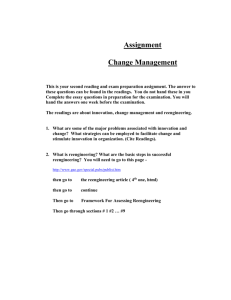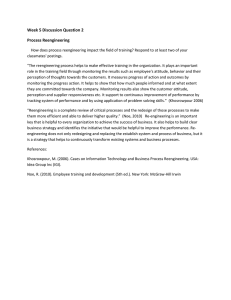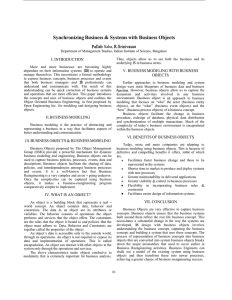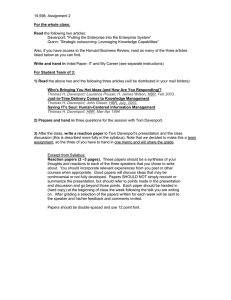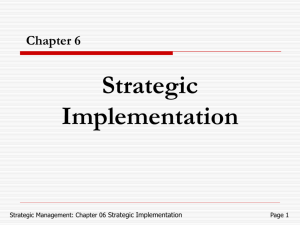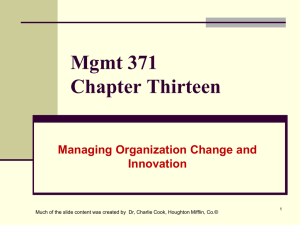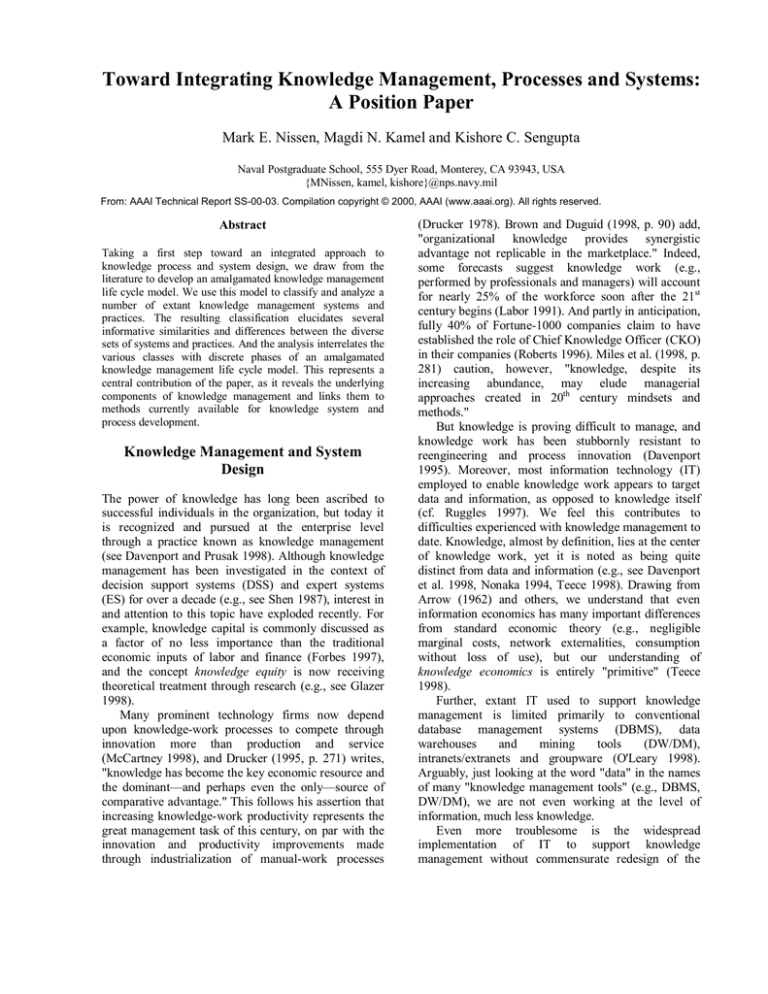
Toward Integrating Knowledge Management, Processes and Systems:
A Position Paper
Mark E. Nissen, Magdi N. Kamel and Kishore C. Sengupta
Naval Postgraduate School, 555 Dyer Road, Monterey, CA 93943, USA
{MNissen, kamel, kishore}@nps.navy.mil
From: AAAI Technical Report SS-00-03. Compilation copyright © 2000, AAAI (www.aaai.org). All rights reserved.
Abstract
Taking a first step toward an integrated approach to
knowledge process and system design, we draw from the
literature to develop an amalgamated knowledge management
life cycle model. We use this model to classify and analyze a
number of extant knowledge management systems and
practices. The resulting classification elucidates several
informative similarities and differences between the diverse
sets of systems and practices. And the analysis interrelates the
various classes with discrete phases of an amalgamated
knowledge management life cycle model. This represents a
central contribution of the paper, as it reveals the underlying
components of knowledge management and links them to
methods currently available for knowledge system and
process development.
Knowledge Management and System
Design
The power of knowledge has long been ascribed to
successful individuals in the organization, but today it
is recognized and pursued at the enterprise level
through a practice known as knowledge management
(see Davenport and Prusak 1998). Although knowledge
management has been investigated in the context of
decision support systems (DSS) and expert systems
(ES) for over a decade (e.g., see Shen 1987), interest in
and attention to this topic have exploded recently. For
example, knowledge capital is commonly discussed as
a factor of no less importance than the traditional
economic inputs of labor and finance (Forbes 1997),
and the concept knowledge equity is now receiving
theoretical treatment through research (e.g., see Glazer
1998).
Many prominent technology firms now depend
upon knowledge-work processes to compete through
innovation more than production and service
(McCartney 1998), and Drucker (1995, p. 271) writes,
"knowledge has become the key economic resource and
the dominant—and perhaps even the only—source of
comparative advantage." This follows his assertion that
increasing knowledge-work productivity represents the
great management task of this century, on par with the
innovation and productivity improvements made
through industrialization of manual-work processes
(Drucker 1978). Brown and Duguid (1998, p. 90) add,
"organizational knowledge provides synergistic
advantage not replicable in the marketplace." Indeed,
some forecasts suggest knowledge work (e.g.,
performed by professionals and managers) will account
for nearly 25% of the workforce soon after the 21st
century begins (Labor 1991). And partly in anticipation,
fully 40% of Fortune-1000 companies claim to have
established the role of Chief Knowledge Officer (CKO)
in their companies (Roberts 1996). Miles et al. (1998, p.
281) caution, however, "knowledge, despite its
increasing abundance, may elude managerial
approaches created in 20th century mindsets and
methods."
But knowledge is proving difficult to manage, and
knowledge work has been stubbornly resistant to
reengineering and process innovation (Davenport
1995). Moreover, most information technology (IT)
employed to enable knowledge work appears to target
data and information, as opposed to knowledge itself
(cf. Ruggles 1997). We feel this contributes to
difficulties experienced with knowledge management to
date. Knowledge, almost by definition, lies at the center
of knowledge work, yet it is noted as being quite
distinct from data and information (e.g., see Davenport
et al. 1998, Nonaka 1994, Teece 1998). Drawing from
Arrow (1962) and others, we understand that even
information economics has many important differences
from standard economic theory (e.g., negligible
marginal costs, network externalities, consumption
without loss of use), but our understanding of
knowledge economics is entirely "primitive" (Teece
1998).
Further, extant IT used to support knowledge
management is limited primarily to conventional
database management systems (DBMS), data
warehouses
and
mining
tools
(DW/DM),
intranets/extranets and groupware (O'Leary 1998).
Arguably, just looking at the word "data" in the names
of many "knowledge management tools" (e.g., DBMS,
DW/DM), we are not even working at the level of
information, much less knowledge.
Even more troublesome is the widespread
implementation of IT to support knowledge
management without commensurate redesign of the
underlying processes. As we learned through the
painful, expensive and failure-prone "first wave" of
reengineering (see Cypress 1994), simply inserting IT
into a process in no way guarantees performance
improvement. This point is underscored by Hammer
(1990), who colorfully refers to such practice as
"paving the cowpaths" (e.g., making a broken process
simply operate broken faster).
Drawing all the way back to Leavitt (1965) and
others (e.g., Davenport 1993, Nissen 1998), new IT
needs to be integrated with the design of the process it
supports, which includes consideration of the
organization, people, procedures, culture and other key
intelligence (e.g., knowledge capture and formalization,
distributed inference, knowledgebase design) and
information systems (e.g., structured and objectoriented analysis & design, database development,
decision support systems). At this stage of our research,
we have identified many compelling examples of wellestablished methodologies, techniques and tools being
composed to support integrated analysis and design of
knowledge systems and processes.
Much of the research outlined in the position
statement above is underway. In the balance of this
paper, we draw from the literature to develop an
amalgamated knowledge management life cycle model.
Table 1 Knowledge Management Life Cycle Models
Model
Phase 1
Phase 2
Phase 3
Phase 4
Phase 5
Nissen
Despres and Chauvel
Gartner Group
Davenport & Prusak
Amalgamated
Formalize
Store
Capture
Codify
Formalize
Distribute
Share/transfer
Access
Transfer
Distribute
Apply
Reuse
Use
Capture
Create
Create
Generate
Create
Organize
Map/bundle
Organize
Organize
factors, in addition to technology. Such integration of
knowledge process design with knowledge system
design is strangely missing from the knowledge
management literature and practice.
The research described in this paper is focused on
knowledge management and system design from three
integrated perspectives: 1) reengineering process
innovation, 2) expert systems knowledge acquisition
and representation, and 3) information systems analysis
and design. Our position is, we can integrate these three
perspectives in a systematic manner, beginning with
analysis and design of the enterprise process of interest,
progressively moving into knowledge capture and
formalization, and then system design and
implementation. Thus, we strive to offer an integrated
approach that covers the gamut of design considerations
from the enterprise process in the large, through
alternative classes of knowledge in the middle, and on
to specific systems in the detail.
The central premise of this position is, although
knowledge management represents a phenomenon of
relatively new widespread interest and attention in
research and practice, many of its underlying elements
are actually quite familiar and have been effectively
addressed for many years (decades in some cases). This
includes work in process redesign (e.g., integration of
information technology enablers with organizational
design, human resources, information availability,
inter-organizational alliance, workflow modification
and other process transformations), artificial
Apply
We use this to classify and analyze a number of extant
knowledge management systems and practices. The
resulting classification elucidates several informative
similarities and differences between the diverse sets of
systems and practices. And the analysis interrelates the
various classes with discrete phases of our
amalgamated knowledge management life cycle model.
This represents a central contribution of the paper, as it
reveals the underlying components of knowledge
management and links them to methods currently
available for knowledge system and process
development.
Amalgamated Knowledge Management
Life Cycle Model
Drawing from Nissen (1999), we begin to observe a
sense of process flow or a life cycle associated with
knowledge management. Although we can describe the
knowledge management life cycle as a sequence of
activities, in practice their performance is generally
iterative. Building upon this notion, we outline key
elements of several life cycle models drawn from the
recent knowledge management literature to develop an
amalgamated knowledge management process model.
In Table 1, we compare the knowledge management
life cycles proposed by several researchers (e.g., Nissen
1999, Despres and Chauvel 1999, Gartner Group 1999,
Davenport and Prusak 1998), which all share
considerable similarities.
Table 2 Organization Level Systems and Practices
Create
Organize
Formalize
Distribute
Data
Knowledge
Data
FAQs
mining
map
warehouse
AI first
Semantic
Reports
Best practices
principles network
R&D
GrapeVines
Lessons
learned
Bench
Knowledge
marking
brokers
Business
"Yellow
intel
Pages"
Web
publication
Document
search
For instance, most of the four life cycle models
begin with a "create" or "generate" phase; only the
Nissen model begins with knowledge capture, an
activity appearing in the third phase of the Gartner
Group model. The second phase pertains to the
organization, mapping or bundling of knowledge;
Davenport and Prusak omit this organization phase
from their model, but it appears very prominently in all
the others. Phase three uses different terms across the
models, but they all address some mechanism for
making knowledge formal or explicit. Likewise, the
fourth phase uses different terms but addresses the
ability to share or distribute knowledge in the
enterprise. Three of the four models include a fifth
phase for application or (re)use of knowledge for
problem solving or decision making in the organization.
Only the Despres and Chauvel model includes a sixth
phase for knowledge evolution.
The Amalgamated model integrates the key
concepts and terms from the four life cycle models.
Comparing the steps above proposed by Nissen (1999)
with this Amalgamated model, notice from Table 1 the
latter life cycle model makes a distinction between
knowledge creation (e.g., as proposed by Despres and
Chauvel and Gartner Group) and its capture or
formalization (i.e., Phase 3). Whereas knowledge
creation involves discovery and the development of
new knowledge, knowledge capture requires only that
the knowledge be new to a particular individual or
organization, and formalization involves the conversion
of existing knowledge from tacit to explicit form. The
Amalgamated model therefore seems more complete
with its beginning at the creation step. Similarly, the
Amalgamated model also adopts the evolution step
from the Despres and Chauvel model. We continue
with this model through the sections that follow.
Apply
BPR
Evolve
Knowledge Management Systems and
Practices
In this section, we draw again from Nissen (1999) to
examine a number of extant systems and practices
employed in the context of knowledge management. To
facilitate analysis, we map these systems and practices
to discrete phases of the Amalgamated Knowledge
Management Life Cycle Model developed above. These
amalgamated life cycle phases are repeated across the
tops of Tables 2-5 for reference. The cells of Tables 2-4
contain examples of current knowledge management
systems and practices drawn from the literature (e.g.,
Davenport et al. 1996, Davenport and Prusak 1998,
Gartner Group 1999, Despres and Chauvel 1999,
others). We use these exemplars from current practice,
not only to populate the table cells, but also to
interrelate them with points along the life-cycle
dimension.
However, in addition to this life-cycle dimension,
we find higher dimensionality is required to map the
more dynamic knowledge management activities
summarized in Table 1. One important dimension along
these lines is knowledge management level, which
draws from Nonaka (1994) and others (e.g., Despres
and Chauvel 1999). The knowledge management level
includes both individual and collective entities, the
latter of which are further distinguished between groups
(e.g., of relatively small collections such as work teams
or functional departments) and organizations (e.g.,
relatively large collections such as enterprises or
corporations). This dimension pertains to the scale of
knowledge management and extends from a single
person, through work groups, to an enterprise as a
whole. Combined with the life cycle steps from above,
we employ these levels in a two-dimensional
framework to classify extant knowledge management
applications.
address knowledge directly and employ a variety of
knowledge representational techniques for its
organization. Without going into great detail, notice a
Table 3 Group Level Systems and Practices
Create
Organize
Formalize
Distribute
Engr BoK
Workflow
Knowledge
Groupware
Exchange
Community
of practice
Discussion
groups
Document
sharing
Workshops
Listservers
Tele
conference
E-mail
Meetings
We begin the discussion with Table 2, which
pertains to organization-level knowledge management.
Tables 3 and 4 are presented subsequently to
incorporate systems and practices applied at the group
and individual levels, respectively. In discussing these
tables, a number of points merit noting. First, arguably,
knowledge creation represents a more difficult and
uncertain process than its capture. Indeed, referring to
Tables 2-4, few systems exist to support knowledge
creation—data mining system conglomerates and
artificial intelligence (AI) from first principles represent
notable exceptions—but a number of enterprise
practices (e.g., corporate research and development
(R&D),
benchmarking,
competitive
business
intelligence) are widely employed for this purpose.
Second, referring back to Table 1, the Gartner
Group collects the organize, formalize and distribute
activities under the common heading "knowledge
sharing." We use this grouping below to help classify
and cluster extant knowledge management technologies
and practices. Continuing across the rows of Table 2,
examples of systems used for enterprise-wide
knowledge organization include knowledge maps and
semantic networks. And from Table 3, group-level
implementations such as Chrylser's Engineering Book
of Knowledge and Anderson Consulting's Knowledge
Exchange are also noted in the literature. Table 4
reveals that, at the individual level, systems to extract
and cluster information by keyword are available, along
with the online thesaurus to interrelate key terms and
concepts in the enterprise. And knowledge-based
systems (KBS; e.g., expert systems, intelligent agents)
Apply
Group DSS
Evolve
number of systems and practices listed under the
knowledge formalization and distribution columns.
Clearly, this represents the current emphasis of most
knowledge management today.
Create
Evolve
Apply
Class II
Expanded View
(performative)
Class I
Localized View
(supportive)
Organize
Formalize
Distribute
Figure 1 Knowledge Management Life Cycle
Third, we note above the Despres and Chauvel life
cycle includes a sixth element, called "evolution," to
represent the refinement and continued development of
existing knowledge. With a little thought, one can see
such refinement and continued development is similar
in many respects to the "maintenance" phases of the
developmental life cycle models common to system and
process development. These models include, for
example, the information system development life cycle
model (SDLC), several expert system development
models and various approaches to business process
reengineering (BPR). And as with nearly all life cycle
models—which we note are laid-out sequentially but
generally performed in an iterative manner—we can
also say that knowledge evolution leads in turn to
further knowledge creation, thereby completing the
cycle and signaling the beginning of new knowledge
capture and sharing (e.g., additional organization,
formalization and distribution of knowledge).
The cyclical nature is more readily discernable
when presented as a circle, as opposed to a linear
sequence of activities, as depicted in Figure 1. Notice
the three "sharing" activities from above—knowledge
organization, formalization and distribution—are
adjacent on the right-hand side of the cycle. From the
tables above, we see these activities correspond with
greater support from extant information technologies
and hence represent more of a localized view of
knowledge management; thus, the grouping under the
"Class I" heading in the figure. We note such, localized
knowledge management systems are inherently
supportive in nature; that is, this class of
implementations to organize, formalize and distribute
knowledge in the enterprise support people in the loop,
who in turn apply, evolve and create knowledge in the
organization.
Alternatively, the latter three, non-sharing activities
are adjacent on the left-hand side of the cycle. But from
the tables we see these activities do not correspond well
with support from extant information technologies and
hence represent an expanded view of knowledge
management; thus, the grouping under the "Class II"
Principal Information Technologies
Table 5 extends the classification of extant knowledge
management systems and practices by identifying the
principal information technologies (ITs) and redesign
transformations used to enable systems and practices
from the various classes and life cycle phases. Take the
first technology listed under the "create" column, for
instance. This entry corresponds with the data mining
class of systems identified in Table 2 above. Here,
Table 5 indicates most data mining applications are
enabled by tools and techniques associated with
sophisticated pattern matching. Similarly, AI firstprinciples reasoning is also listed under the "create"
column in Table 2. Here, Table 5 indicates most firstprinciples applications are enabled through the kind of
automated inference performed by KBS.
As other instances from Tables 2 and 5,
respectively, many corporate R&D processes are
transformed through concurrent engineering methods,
benchmarking is generally conducted through
comparative process analysis, and the collection of
most competitive business intelligence is predicated on
business research. The other technologies and
transformations follow accordingly for Tables 2-4 and
should be self-explanatory to the likely reader of this
paper.
Notice, looking across the rows at the rightmost
column, we identify one or more of the common
methodologies identified above—reengineering (BPR),
Table 4 Individual Level Systems and Practices
Create
Organize
Formalize
Distribute
Keyword
Information
extract
retrieval
Online
Document
thesaurus
mgmt
KBS
KBS
KBS
heading in the figure. We note such, expanded
knowledge management systems are inherently
performative in nature; that is, this class of
implementations to apply, evolve and create knowledge
in the enterprise perform knowledge-management
activities, either in conjunction with or in lieu of people
in the organization. Referring back to the tables above,
however, we note very few extant knowledge
management systems currently capable of performing
in this manner. This may highlight a promising area for
future knowledge management research and system
development.
Apply
Data
visualization
Evolve
KBS
expert systems (ES) or information systems (IS)—that
would be appropriate to develop each principal IT or
redesign transformation. For instance, conventional IS
methods are generally employed to develop association
lists, and ES approaches are required for implementing
most semantic nets. Several important points can be
drawn from this table. First, notice the relative sparsity
of applications outside the three "sharing" columns (i.e.,
beyond knowledge organization, formalization and
distribution). At least as described in the literature, the
great majority of knowledge management applications
pertain to sharing knowledge that already exists in the
enterprise. This supports our classification above in
terms of a limited view of knowledge management, as
it excludes knowledge creation, application and
evolution, which are necessary to complete the life
cycle. Indeed, we omit the "evolve" column in this
table, because a dearth of technologies and practices is
presently available for knowledge management at this
step of the life cycle.
to support concurrent engineering involves both
information
systems
and
process
redesign
methodologies and techniques. Indeed, where certain
technologies and transformations are developed
together (e.g., combining concurrent engineering with
workflow technology), data from Table 5 indicate all
three developmental approaches (i.e., reengineering,
Table 5 Principal Enabling ITs and Transformations
Create
Organize
Formalize
Distribute
Pattern
matching
Automatic
inference
Concurrent
engr
Process
analysis
Business
research
Automatic
inference
Automatic
inference
Automatic
inference
Apply
Developmental
Approach
IS, ES
Automatic
inference
ES
IS, BPR
BPR
Association
lists
Semantic net
Database
Web/Notes
Text search
IS
Database
Web/Notes
Text index
Database
Web/Notes
Search
engine
Workflow
Groupware
VTC
Listserver
GDSS
Graphics
Second, every principal IT and transformation used
to enable knowledge management systems and
practices (i.e., listed in the table) is addressed by at least
one current methodology. In other words, our current
set of BPR, ES and IS methodologies provides the
necessary set of capabilities to design and develop this
entire collection of technologies and transformations
used to enable extant knowledge management systems
and processes. This supports our premise that extant
methodologies, techniques and tools can be employed
to develop knowledge management systems.
Third, a number of principal ITs and
transformations require multiple developmental
approaches. For instance, sophisticated patternmatching tools and techniques employed to develop
data mining applications require a synthesis of IS and
ES approaches, and transformation of an R&D process
ES
IS
IS
IS
IS
IS, BPR
IS
IS
IS
IS
IS
expert systems and information systems) are required.
The table thus suggests that no single methodology—or
pair of methodologies—and related set of techniques
and tools is sufficient to develop all knowledge
management systems and processes. This supports our
premise that an integrated approach to knowledge
system and process design is necessary.
Conclusions and Future Research
The research described in this paper has focused on
knowledge management and system design from three
integrated perspectives: 1) reengineering process
innovation, 2) expert systems knowledge acquisition
and representation, and 3) information systems analysis
and design. Our position is, we can integrate these three
perspectives in a systematic manner, beginning with
analysis and design of the enterprise process of interest,
progressively moving into knowledge capture and
formalization, and then system design and
implementation. Thus, we strive to offer an integrated
approach that covers the gamut of design considerations
from the enterprise process in the large, through
alternative classes of knowledge in the middle, and on
to specific systems in the detail.
Through this paper, we draw from the literature to
develop an amalgamated knowledge management life
cycle model. We use this to classify and analyze a
number of extant knowledge management systems and
practices. The resulting classification elucidates several
informative similarities and differences between the
diverse sets of systems and practices. And the analysis
interrelates the various classes with discrete phases of
an amalgamated knowledge management life cycle
model. This represents a central contribution of the
paper, as it reveals the underlying components of
knowledge management and links them to methods
currently available for knowledge system and process
development.
A number of other important findings and
conclusions emerge from this research. For one, despite
the abundance of knowledge management life cycles
that now appear in the literature, they all share
considerable similarities and can be integrated into an
amalgamated model to describe a broad diversity of
knowledge management work in the enterprise. As
another, if harnessed appropriately, the current
repertoire of IT methodologies, technologies and tools
has much to offer for the design and development of
knowledge management systems.
At the same time, as Tables 2-4 show, we note a
relative sparsity of systems and practices associated
with our expanded view of knowledge management
(e.g., Class II systems and practices); that is, few extant
applications and processes address the corresponding,
performative knowledge management life cycle phases
(i.e., apply, evolve, create). We feel this highlights a
promising area for future research, particularly in the
AI field. For instance, AI research has addressed
knowledge application directly for several decades
(e.g., through work on expert systems, planning). As
another instance, machine learning algorithms
explicitly address knowledge evolution (e.g., through
work on rule induction, unsupervised learning), and
reasoning from first principles is identified above as a
viable AI approach to knowledge creation.
Another important conclusion from this research is,
we feel contextual factors may play a critical role in the
design and implementation of knowledge systems and
processes.
We contend effective knowledge
management is a question of tailoring technical and
process solutions to fit the exigencies of the context in
which activities are being performed. Thus, we
recognize the need to address this by integrating critical
contextual factors into the analysis. This may represent
another fruitful step for continued research along the
lines of this investigation.
For instance, the design space for KM systems can
be further defined and constrained by a set of
contextual factors that impinge on the implementation
of these systems in organizations. At this stage in the
research, we can identify two primary factors: 1) the
organization, and 2) the nature of knowledge
underlying the task. Toward the first (i.e., addressing
contextual factors associated with the organization), we
would divide the research into three parts: 1) the role of
organizational memory, 2) structure of the organization,
and 3) organizational incentives. Toward the second
(i.e., addressing the nature of knowledge underlying the
task), we feel the research should at least differentiate
between canonical and non-canonical practices, for
which process codification is relatively more or less
practical, respectively.
The work described in this paper offers several
other logical extensions for future research. One such
extension, for instance, would delineate the contingent
nature of knowledge management. As an example, one
could endeavor to specify in greater detail the
interaction between information technologies and
practices with organizational activities, thereby
enabling designers to identify "families" of solutions
that are likely to succeed as knowledge system and
process implementations. Clearly, this represents only a
short, partial list of future research topics. Knowledge
management remains a relatively novel focus of
research, and much work needs to be accomplished to
advance our knowledge and technological level in this
area. We hope to have contributed to such knowledge
and level by illustrating how current systems and
practices—and their corresponding developmental
methods—can be mapped to our amalgamated
knowledge management life cycle model. And we hope
to have taken a step toward integrated analysis and
design of knowledge systems and processes.
References
Arrow, K. "Economic Welfare and the Allocation of
Resources for Invention," in: R. Nelson (Ed.),
The Rate and Direction of Inventive Activity. Princeton
University Press: Princeton, NJ (1962).
Brown, J.S. and Duguid, P. "Organizing Knowledge,"
California Management Review 40:3 (Spring 1998), pp.
90-111.
Caron, J.R., Jarvenpaa S.L., and Stoddard, D.B.
"Business reengineering at CIGNA corporation:
experiences and lessons learned from the first five
years," MIS Quarterly (September 1994), pp. 233-250.
Cypress, H.L. "Reengineering - MS/OR imperative:
make second generation of business
process improvement mode work," OR/MS Today
(February 1994), pp. 18-29.
Davenport, T.H. Process Innovation: Reengineering
Work through Information Technology
Harvard Press, Boston, MA (1993).
Davenport, T.H. “Business Process Reengineering:
Where It’s Been, Where It’s Going,” in
Business Process Change: Reengineering Concepts,
Methods and Technologies, V. Grover and
W. Kettinger (eds.), Idea Publishing, Middletown, PA
(1995), pp. 1-13.
Davenport, T.H., Jarvenpaa, S.L. and Beers, M.C.
"Improving Knowledge Work Processes," Sloan
Management Review (Summer 1996).
Davenport, T.H., De Long, D.W. and Beers, M.C.
"Successful Knowledge Management Projects,"
Sloan Management Review (Winter 1998), pp. 43-57.
Davenport, T.H. and Prusak, L. Working Knowledge:
How Organizations Manage what they Know. Harvard
Business School Press: Boston, MA (1998).
Despres, C. and Chauvel, D. "Mastering Information
Management: Part Six – Knowledge Management,"
Financial Times (8 March 1999), pp. 4-6.
Drucker, P.F. The Age of Discontinuity. Harper and Row:
New York, NY (1978).
Drucker, P.F. Managing in a Time of Great Change.
Truman Talley: New York, NY (1995).
Forbes, Special Focus on Intellectual Capital, Forbes
ASAP (7 April 1997).
Frappaolo, C. "Defining Knowledge Management: Four
Basic Functions," Computerworld 32:8
(23 February 1998).
Gartner Group. "Knowledge Management Scenario,"
conference presentation, SYM8KnowMan1098Kharris
(1998).
Glazer, R. "Measuring the Knower: Towards a Theory
of Knowledge Equity," California Management Review
40:3 (Spring 1998), pp. 175-194.
Hammer, M. "Reengineering work: don't automate,
obliterate," Harvard Business Review
(July/August 1990), pp. 104-112.
Hammer, M. and Champy J. Reengineering the
Corporation: A Manifesto for Business
Revolution Harper Business Press, New York, NY
(1993).
Labor. U.S. Department of Labor Report (1991).
Leavitt, H.J. "Applying organizational change in
industry: structural, technological and
humanistic approaches," in: J. March (Ed.), Handbook
of Organizations Chicago, IL: Rand McNally (1965).
McCartney, L. "Getting Smart about Knowledge
Management," Industry Week (4 May 1998).
Miles, G., Miles, R.E., Perrone, V. and Edvinsson, L.
"Some Conceptual and Research Barriers to the
Utilization of Knowledge," California Management
Review 40:3 (Spring 1998), pp. 281-288.
Nissen, M.E. "Redesigning Reengineering through
Measurement-Driven Inference," MIS
Quarterly 22:4 (1998), pp. 509-534
Nissen,
M.E.
"Knowledge-Based
Knowledge
Management in the Reengineering Domain," Decision
Support Systems Special Issue on Knowledge
Management (forthcoming 1999).
Nonaka, I. "A Dynamic Theory of Organizational
Knowledge Creation," Organization Science 5:1
(1994), pp. 14-37.
O'Leary, D.E. "Enterprise Knowledge Management,"
Computer (March 1998).
Roberts, B. "Internet as Knowledge Manager," Web
Week (9 September 1996), p. 30.
Ruggles, R. Knowledge Management Tools ButterworthHeinemann: Boston, MA (1997).
Shen, S. "Knowledge Management in Decision Support
Systems," Decision Support Systems 3
(1987), pp. 1-11.
Teece, D.J. "Research Directions for Knowledge
Management, California Management Review
40:3 (Spring 1998), pp. 289-292.

